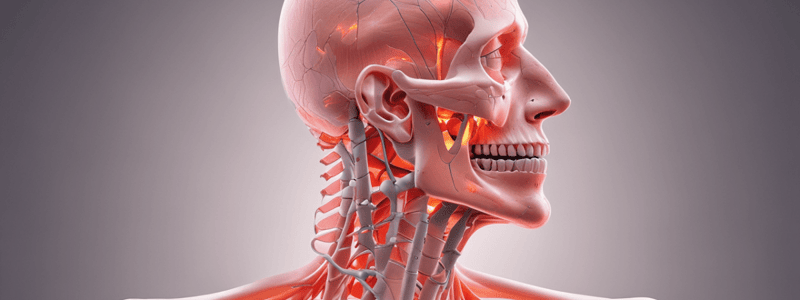Podcast
Questions and Answers
Which position is recommended for imaging the infraspinatus using ultrasound?
Which position is recommended for imaging the infraspinatus using ultrasound?
- Lying on the back
- Standing with arm overhead
- Seated with arm across the chest (correct)
- Lying on the stomach
How should the wrist be positioned during ultrasound imaging to follow the median nerve?
How should the wrist be positioned during ultrasound imaging to follow the median nerve?
- Palm facing outward
- Palm face up (correct)
- Palm face down
- Palm facing inward
What should be the indication of plantar fasciitis when imaging the ankle and foot with ultrasound?
What should be the indication of plantar fasciitis when imaging the ankle and foot with ultrasound?
- Plantar fascia more than 5mm
- Plantar fascia exactly 4mm (correct)
- Plantar fascia not visible
- Plantar fascia less than 2mm
How should the knee be positioned during ultrasound imaging to visualize anatomy effectively?
How should the knee be positioned during ultrasound imaging to visualize anatomy effectively?
What type of features may tears exhibit when viewed through ultrasound imaging?
What type of features may tears exhibit when viewed through ultrasound imaging?
Which of the following is NOT an indication for using bedside musculoskeletal ultrasonography?
Which of the following is NOT an indication for using bedside musculoskeletal ultrasonography?
Which of the following musculoskeletal structures appears as an echogenic linear fibrillar texture on ultrasound?
Which of the following musculoskeletal structures appears as an echogenic linear fibrillar texture on ultrasound?
When scanning the supraspinatus tendon, what is the correct patient positioning?
When scanning the supraspinatus tendon, what is the correct patient positioning?
Which of the following musculoskeletal structures appears as a thin anechoic line on ultrasound?
Which of the following musculoskeletal structures appears as a thin anechoic line on ultrasound?
When scanning the long head of the biceps brachii tendon, what is the correct patient positioning?
When scanning the long head of the biceps brachii tendon, what is the correct patient positioning?
Which of the following musculoskeletal structures appears as an echogenic linear structure attaching bone to bone on ultrasound?
Which of the following musculoskeletal structures appears as an echogenic linear structure attaching bone to bone on ultrasound?
Flashcards are hidden until you start studying
Study Notes
Musculoskeletal Ultrasound
- Infraspinatus muscle is imaged using the posterior approach under the scapular spine, with the patient seated in the "pledge of allegiance stance" (arm across the chest).
- Increasing depth in this view helps to visualize the glenoid joint and labrum.
Wrist and Hand Ultrasound
- Wrist ultrasound: scan with the palm facing up, starting in the middle of the forearm and moving distally to the wrist, to follow the median nerve (transverse and sagittal/long axis).
- Finger ultrasound: scan with the palm up (flexor) or down (extensor) to visualize tendons.
Knee and Ankle Ultrasound
- Knee ultrasound: lift the knee up a bit, keeping the transducer perpendicular to the anatomy.
- Ankle and foot ultrasound: point the notch towards the heel, and the plantar fascia should be approximately 4mm in thickness, indicating fasciitis if thicker.
Tears and Ultrasound
- Tears on ultrasound have anechoic features and appear blurry.
Ultrasound-Guided Procedures
- Ultrasound is used to guide procedures such as fracture and joint relocation, arthrocentesis, and fracture hematoma block to visualize the exact location for aspiration, block, or relocation.
Musculoskeletal Ultrasound Indications
- Bedside ultrasonography is used to evaluate suspected musculoskeletal pathology and guide related procedures.
- Indications include visualizing small tears or joint instability.
- Use the high-frequency linear transducer and MSK exam preset.
- Ensure the transducer is perpendicular to the anatomy to avoid anisotropy and distorted images.
Musculoskeletal Anatomy on Ultrasound
- Subcutaneous fat: located right under the skin.
- Muscle: echogenic with linear bands (striations) in the tissue.
- Tendons: echogenic with linear fibrillar texture bands attaching muscles to bones.
- Bursa: thin anechoic line in the joint.
- Ligaments: echogenic linear structures attaching bone to bone.
- Nerve: has a honeycomb appearance.
Scanning Technique
- Correct scanning technique involves selecting the appropriate probe and patient positioning.
- Shoulder ultrasound: image the long head of the biceps brachii tendon with the patient sitting, palm up, and scan in transverse and long axis.
- Supraspinatus tendon ultrasound: use the transverse view with the patient in the "superman pose" (hand in back pocket) and scan on the anterior side.
- Subscapularis ultrasound: use the transverse approach, anteriorly, with the patient abducting the forearm with the elbow next to the side, and palm up.
Studying That Suits You
Use AI to generate personalized quizzes and flashcards to suit your learning preferences.




